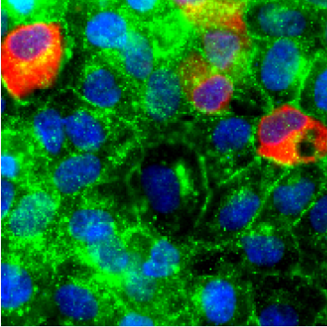Dahl uses sensors to measure forces within cell monolayers
Kris Dahl is using a new technique called SINK (sensors from intranuclear kinetics) to observe the properties of an entire monolayer of cells and determine how broadly cells communicate.
“Physicists have always been interested in how polymers move,” says Kris Dahl, a chemical engineering professor at Carnegie Mellon University who uses physics to study the way DNA, as a polymer, condenses and opens certain regions to express different parts of the genome. Dahl explains, “[Constrained polymers] purposefully condense to maintain the overall openness of the system that we call entropy.”
In her research, Dahl has employed a new technique called SINK, which stands for "sensors from intranuclear kinetics". She got the idea for the technique from a conversation with Provost James Garrett, a civil and environmental engineer whose research has focused on applying sensors to civil infrastructure. The theory is that, by placing sensors in certain positions, researchers do not have to use up resources placing sensors everywhere. SINK is Dahl’s way of applying that theory to cell monolayers. By placing a few sensors across a monolayer within different cells’ nuclei in their condensed polymeric regions, Dahl and her team can observe the properties of an entire monolayer, or sheet, of cells.
Understanding how these monolayers of cells behave is critical to understanding disease progression and embryonic development.
Travis Armiger, Senior Scientist, Merck
Through looking at how the sensors bound in condensed DNA “jiggle,” as Dahl says, she and her team discovered that a change in one cell can impact a larger range of cells around it than was previously thought. “We thought it would change the cells right next to it, but it turns out it changes at least five cells, maybe up to 10 cells, in every direction,” says Dahl. According to her former Ph.D. student, Travis Armiger, “Understanding how these monolayers of cells behave in response to physical forces, in addition to their response to chemical signals, is critical to understanding disease progression and embryonic development.” The discovery could be particularly important for diseases such as cancer.
The work was the subject a paper Dahl and Armiger recently had published in the Journal of Cell Science. Dahl will present that and the work of another paper about DNA damage and repair at the American Physical Society’s (APS) annual conference in March 2019. APS invited her to give the talk because of the physical component of her research.

Source: Kris Dahl
A cell monolayer with immunofluorescence performed against E-cadherin, an important molecule in cell-cell adhesion.
Another part of Dahl’s research that she finds particularly interesting is how cells interact with one another within a monolayer. Instead of modeling a monolayer as a simple sheet of material, monolayers of cells can be modeled as colloidal crystals, which are self-assembled structures of spheres that assemble with lose interactions rather than tight bonds. Modeling monolayers as colloidal crystals means that the thermodynamics of their assembly are different and that they deform differently from how researchers expected. Instead of stretching like a rubber glove, cell monolayers will form propagating defects because of their loose associations, and the cells’ unique interactions become particularly important in areas like tissue engineering.
While Dahl and her team have figured out that cells within a monolayer are communicating more broadly than previously thought, they have yet to determine how exactly the cells are mechanically communicating with each other.
“That’s an exciting area of future research,” says Dahl. She is exited that more researchers are taking up her SINK technique to continue learning more about cells and their interactions. “We have collaborators all over the country and all over the world. It definitely makes finding a time to Skype difficult.”
